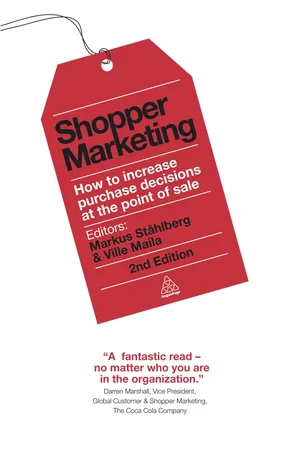Retailers in Marketing
Retailers in marketing are businesses that sell products or services directly to consumers. They play a crucial role in the distribution channel by providing a physical or online location for customers to purchase goods. Retailers often engage in marketing activities to attract customers, such as advertising, promotions, and creating a positive shopping experience.
5 Key excerpts on "Retailers in Marketing"
- eBook - ePub
Sales and Marketing Channels
How to Build and Manage Distribution Strategy
- Julian Dent, Michael White(Authors)
- 2018(Publication Date)
- Kogan Page(Publisher)
...22 Insights from managing consumer goods distribution and retailers Retailers and retailing What distinguishes retailers from all other types of final-tier players? The generally accepted definition of retailing is that it consists of selling products and services to the ultimate consumer for private consumption. By and large that’s whom retailers sell to, though not exclusively, as small business will also often use retailers for convenience (and sometimes for price). You will have noticed that the definition makes no mention of shops or stores. Retailers today go to market through many selling portals, including stores, catalogues, mail-order, the web and telesales. In some cases, players who started out as web-based only, such as Amazon, have opted to introduce stores into their channel mix. There is a general consensus that the long-term survivors in this sector will need to adopt an ‘omni-channel’ approach. In consumer goods distribution, the goal of the retailer, whether physical, virtual or both, is to attract customers to its store, get them to ‘shop’ the store, get them to buy the best ‘mix’ (ie the most profitable lines) in the store and to get them to come back again. This very simple model (see Figure 22.1) underpins all the businesses in this sector, but the way it changes by channel provides insight into some of the pressures being faced by some major players. Figure 22.1 Fundamental retail business model Fundamental retail business model Store-based channels It is easiest to start with the store-based retail selling motion, ie selling through physical retail premises, located in places that are convenient for the target customer...
- eBook - ePub
Technology Distribution Channels
Understanding and Managing Channels to Market
- Julian Dent(Author)
- 2014(Publication Date)
- Kogan Page(Publisher)
...Part Four Retailers 19 The role of retailers Retailers and retailing What distinguishes retailers from all other types of final-tier players? The generally accepted definition of retailing is that it consists of selling products and services to the ultimate consumer for private consumption. And by and large that’s whom retailers sell to, though not exclusively as small businesses are increasingly using retailers for convenience (and sometimes for price). You will have noticed that the definition makes no mention of shops or stores. Many retailers today go to market through many selling motions, including stores, catalogues, mail-order, the web, apps and tele-sales. In addition, most retailers have now mastered, to some degree, multi-motion integration. This means allowing the customer to move seamlessly across the selling motions. A simple example is ‘click and collect’, where the purchase is made through a website or an app and then collected from a physical store. In this section we are going to start with the store-based retail selling motion, ie selling through physical retail premises, located in places that are convenient for the target customer. We will examine the business models of the other selling motions later on and you will see that they have much in common with the store-based motion...
- eBook - ePub
Shopper Marketing
How to Increase Purchase Decisions at the Point of Sale
- Markus Ståhlberg, Ville Maila(Authors)
- 2012(Publication Date)
- Kogan Page(Publisher)
...Since the late 1970s, his market research has focused on shoppers at their points of purchase, capturing their behaviour, motivations and perceptions. Retailing is a relationship business Retailing is all about bringing people together with the things they want and need. It has always been at the cutting edge of social evolution – and always will be. To really understand retailing, it is helpful to think of it in relationship terms. That is, to think in terms of the variety of relationships that most seriously impact on retail. These are illustrated in Figure 9.1. For much of retail, the dominant relationship driving the practice is that between the retailer and the product suppliers. This is especially true in a self-service world where the retailer’s primary responsibility is (1) to provide a store (2) stocked with merchandise, and the primary responsibility of the supplier is just that – to supply the merchandise with which the store is stocked. This leaves the self-service customers to self-build their own relationships, primarily with the store and the product within, the retailer and supplier being remote parties of little interest to or involvement with the customer. Glen Terbeek captured the essence of these relationships in The Agentry Agenda (Figure 9.2). This is the stark reality that drives a good deal of retailing. Retailers and suppliers do seek to have a relationship with shoppers, but their own mutual relationship tends to cause those with the shoppers to pale into insignificance, and to remain somewhat distant, by comparison. This is the reality of self-service retail. FIGURE 9.1 Variety of retail relations FIGURE 9.2 Relationships among retailers, suppliers and shoppers (Terbeek, 1999: 34) The ‘give–gets’ of the shopper in the store The purpose of this chapter is to examine in more detail the relationships that shoppers develop with the store and the products...
- eBook - ePub
Store Wars
The Worldwide Battle for Mindspace and Shelfspace, Online and In-store
- Greg Thain, John Bradley(Authors)
- 2012(Publication Date)
- Wiley(Publisher)
...Chapter 4 RETAILERS AND THE MARKETING CONCEPT RETAILERS AND MANUFACTURERS not only differ in financing, and structure; they also follow very different consumer strategies. This is because their structural differences profoundly affect the power and relative importance of key elements of the marketing mix. In particular: Segmentation: Retailers cannot segment consumers to the degree that manufacturers do and, as a consequence, must favour broader rather than pointed positionings. However, to achieve a workable level of segmentation, retailers are increasingly moving towards multiple store formats across multiple channels, including online, that appeal to different shopping needs. Brand proliferation is very limited when applied to retail chains, where the predominant retail strategy is for one overarching retail brand with perhaps a handful of private label sub-brands. This is in complete contrast to the manufacturing world, where companies handle vast portfolios of distinct brands. Retailers, in general, welcome brand proliferation from manufacturers but are increasingly wary of SKU proliferation within brands. While the number of brands offered has been shown to exert a positive correlation on store choice, the number of SKUs per brand and the number of sizes per brand actually have a slightly inverse effect. 1 Based on our research, anything less than 1000 SKUs or more than 40 000 in a store can present more negatives than positives for a retailer. Role of quality: The quality of the shopping experience provides weaker differential advantages than quality can bring to product brands, but it can still have an impact. As retailers add new services, such as banking, insurance etc., they can strengthen the quality of the shopping experience and enter new markets. Brands, on the other hand, have long covered virtually all viable quality positionings. Importance of price: Price is imperative for FMCG retailers, much more so than for manufacturers...
- Bonita Kolb(Author)
- 2020(Publication Date)
- Routledge(Publisher)
...This can greatly increase the number of consumers who have the opportunity to conveniently purchase the product. However, the intermediary will also need to make a profit on the sale of the product. Either the producer must sell the product more cheaply to the intermediary so that once it is marked up the price will still be the same as it was originally, or the final retail price will be higher. To use an intermediary, the producer must understand the process involved in selling the product to retailers. Formerly the organization had to decide if they should distribute through stores or online. Now, the question is no longer relevant as the bricks and mortar and online worlds have merged. Retail stores that formerly had a separate ecommerce and physical store marketing division have now merged them into one. Shoppers make no distinction between buying online and onsite. They will use both based on convenience (LaFleche 2019). A consumer may use a company’s website that shows photos of the product and describes the product details for research. They may then purchase in a store. Or, they do the opposite, researching in a store but then buying online. Distribution challenges—not as easy as you would think The problem that distribution addresses is that the product may exist in one place while the consumer lives somewhere else. Intermediaries are the people and organizations that solve this problem. While this is easy to understand for tangible products, the issue is also the same for service products such as performances. In these cases, an agent is often used as an intermediary. The agent will book the venues where the entertainment takes place for either a flat fee or a percentage of the money earned by the entertainer...




